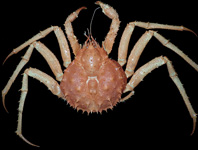Abstract
Scinax Wagler currently harbors 72 treefrog species distributed throughout the Neotropical region, occurring from Mexico to Argentina and Uruguay, and also in some Caribbean islands (Frost et al. 2020). The genus has a high level of cryptic diversity, with its actual number of species currently considered to be underestimated (Fouquet et al. 2007, Ferrão et al. 2016). Scinax funereus (Cope) is a medium-sized species described from Moyobamba, San Martín Department, northern Peru, with occurrences reported from the Peruvian and Ecuadorian Amazon (Duellman & Wiens 1993), southern Colombia (Lynch 2005), and from the Brazilian states of Acre (Bernarde et al. 2011) and Amazonas (Ramalho et al. 2016). Duellman (1978) reported that the advertisement call of S. funereus “consists of a moderately long, rather high-pitched, single note”, but as no call recording was obtained at the time, it was not described. Although Read (2000) published the species’ call in the audio form in a compact disc (CD), it was not formally described. Given this, herein we provide the first formal description of the advertisement call of S. funereus.
References
Acosta-Galvis, A.R. (2018) Una nueva rana de huesos verdes del género Scinax (Anura: Hylidae) asociada a los bosques subandinos de la cuenca del río Magdalena, Colombia. Biota Colombiana, 19, 131–159.
https://doi.org/10.21068/c2018.v19s1a11
Audacity Team (2020) Audacity(R): Free Audio Editor and Recorder. Version 2.2.2. Available from https://audacityteam.org/ (accessed 7 July 2020)
Bernarde, P.S., Machado, R.A. & Turci, L.C.B. (2011) Herpetofauna da área do Igarapé Esperança na Reserva Extrativista Riozinho da Liberdade, Acre-Brasil. Biota Neotropica, 11 (3), 117–144.
https://doi.org/10.1590/S1676-06032011000300010
Center for Conservation Bioacoustics (2014) Raven Pro: Interactive Sound Analysis Software. Version 1.5. Computer software. The Cornell Lab of Ornithology, Ithaca, NY: Available from: http://ravensoundsoftware.com (accessed 7 July 2020)
De la Riva, I., Márquez, R. & Bosch, J. (1994) Advertisement calls of Bolivian species of Scinax (Amphibia, Anura, Hylidae). Bijdragen tot de Dierkunde, 64 (2), 75–85.
https://doi.org/10.1163/26660644-06402002
Duellman, W.E. (1971) The identities of some Ecuadorian hylid frogs. Herpetologica, 27 (2), 212–227.
Duellman, W.E. (1978) The biology of an equatorial herpetofauna in Amazonian Ecuador. Miscellaneous Publications, University of Kansas Museum of Natural History, 65, 1–352.
Duellman, W.E. & Wiens, J.J. (1993) Hylid frogs of the genus Scinax Wagler, 1830 in Amazonian Ecuador and Peru. Occasional Papers of the Museum of Natural History, University of Kansas, 153, 1–57.
Ferrão, M., Colatreli, O., de Fraga, R., Kaefer, I.L., Moravec, J. & Lima, A.P. (2016) High species richness of Scinax treefrogs (Hylidae) in a threatened Amazonian landscape revealed by an integrative approach. Plos one, 11 (11), e0165679.
https://doi.org/10.1371/journal.pone.0165679
Fouquet, A., Vences, M., Salducci, M.D., Meyer, A., Marty, C., Blanc, M. & Gilles, A. (2007) Revealing cryptic diversity using molecular phylogenetics and phylogeography in frogs of the Scinax ruber and Rhinella margaritifera species groups. Molecular Phylogenetics and Evolution, 43 (2), 567–582.
https://doi.org/10.1016/j.ympev.2006.12.006
Frost, D.R. (2020) Amphibian species of the world: an online reference. Version 6.0. American Museum of Natural History, New York. Available from: http://research.amnh.org/herpetology/amphibia/index.html (accessed 1 April 2020)
Köhler, J., Jansen, M., Rodríguez, A., Kok, P.J.R., Toledo, L.F., Emmrich, M., Glaw, F., Haddad, C.F.B., Rödel, M.-O. & Vences, M. (2017) The use of bioacoustics in anuran taxonomy: theory, terminology, methods and recommendations for best practice. Zootaxa, 4251 (1), 1–124.
https://doi.org/10.11646/zootaxa.4251.1.1
Lynch, J.D. (2005) Discovery of the richest frog fauna in the world--an exploration of the forests to the north of Leticia. Revista de la Academia Colombiana de Ciencias Exactas, Físicas y Naturales, 29 (113), 581–589.
Ramalho, W.P., Andrade, M.S., de Matos, L.R.A. & Vieira, L.J.S. (2016) Amphibians of varzea environments and floating meadows of the oxbow lakes of the Middle Purus River, Amazonas, Brazil. Biota Neotropica, 16 (1), e20150093.
https://doi.org/10.1590/1676-0611-BN-2015-0093
R Core Team (2018) R: a language and environment for statistical computing. R Foundation for Statistical Computing, Vienna, Austria. Version 3.5.2. Available from: http://www.R-project.org (accessed 5 May 2020)
Read, M. (2000) Frogs of the Ecuadorian Amazon, a guide to their calls. Morley Read Productions, England, Cornwall. [CD]
Ron, S.R., Duellman, W.E., Caminer, M.A. & Pazmiño, D. (2018) Advertisement calls and DNA sequences reveal a new species of Scinax (Anura: Hylidae) on the Pacific lowlands of Ecuador. Plos one, 13 (9), e0203169
https://doi.org/10.1371/journal.pone.0203169
Sueur, J., Aubin, T. & Simonis, C. (2008) Seewave, a free modular tool for sound analysis and synthesis. Bioacoustics, 18, 213–226.
https://doi.org/10.1080/09524622.2008.9753600


